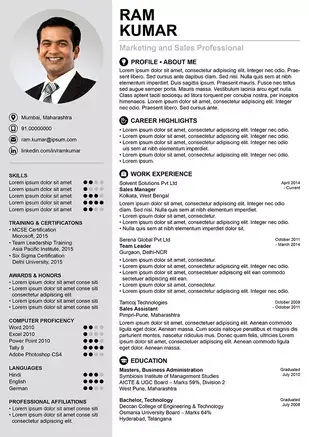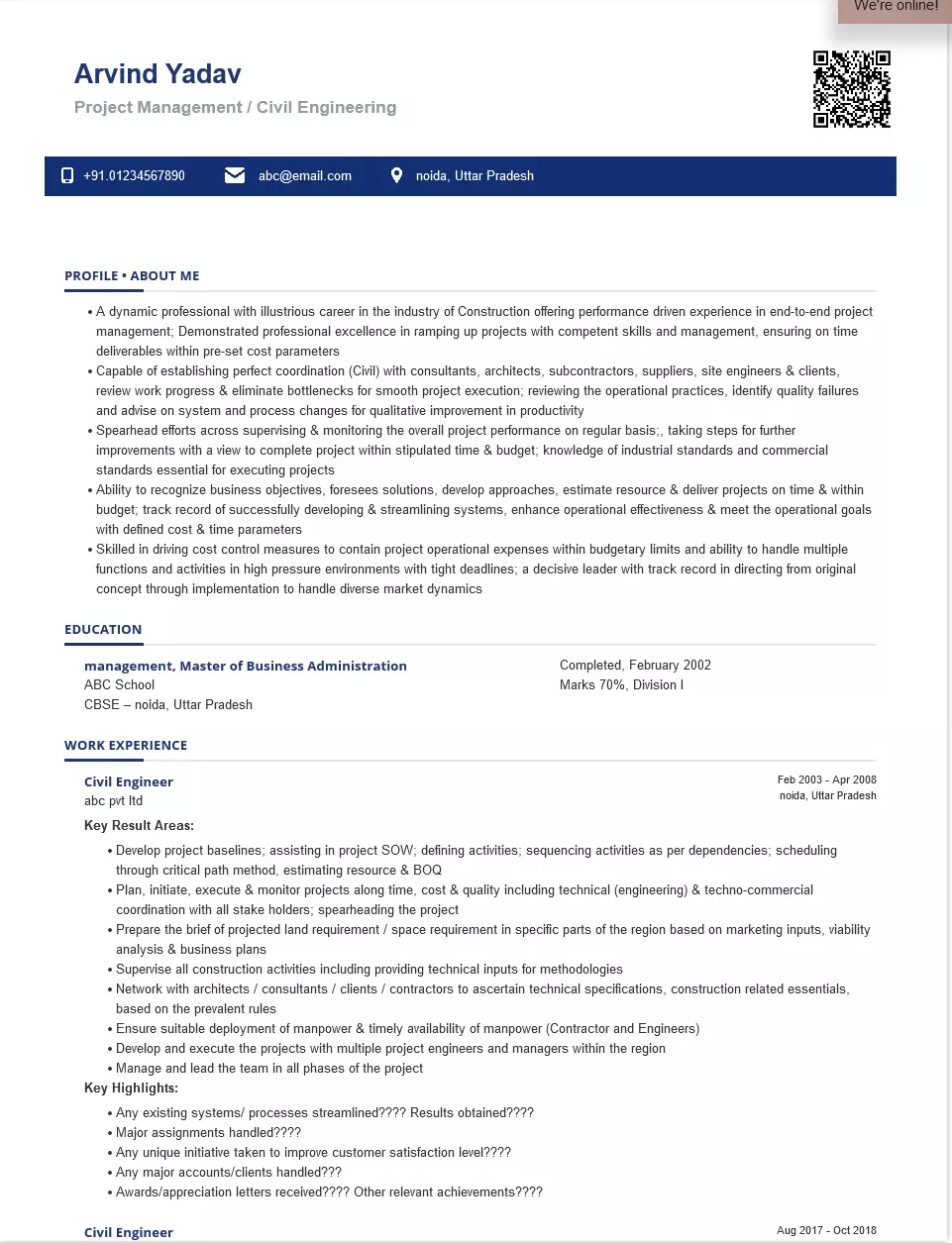- Certified Engineering Technologist (CET), Completed , January 2018
What's your job?
Civil Engineer Resume Samples and Templates for 2025
- Table of Contents
- Downloadable Sample
- Resume Tips from Experts
- Resume Text Version
- Share
Civil Engineer Resume Guide for India
A well-crafted civil engineer resume is essential for success in India’s booming infrastructure and construction sector. Whether you’re a fresher from IIT, NIT, or other engineering colleges or an experienced professional seeking positions at top companies like L&T, Tata Projects, or Shapoorji Pallonji, this guide provides everything you need to create a standout resume that impresses Indian employers and passes ATS screening on portals like Naukri and LinkedIn.
This comprehensive guide includes:
- Resume format recommendations for Indian construction sector
- Key skills Indian employers look for
- Complete resume example with Indian context
- Top civil engineering employers in India
- Salary insights in INR by experience level
- Certification guidance for the Indian market
- ATS optimization tips for Naukri and LinkedIn
Why Your Civil Engineer Resume Matters in India
India’s infrastructure sector is among the largest in the world, with massive investments in roads, metro rail, airports, smart cities, and housing. Companies like L&T (Larsen & Toubro), Tata Projects, Shapoorji Pallonji, GMR, and Adani actively hire qualified civil engineers. A strong resume helps you:
- Stand out from thousands of B.Tech graduates applying on Naukri and LinkedIn
- Pass ATS screening used by major construction and infrastructure companies
- Showcase skills that Indian project managers value, including AutoCAD, structural design, and site management
- Demonstrate your project experience and technical expertise
Indian recruiters typically spend 6-10 seconds reviewing each resume initially. Your civil engineer resume must immediately communicate your technical qualifications, project experience, and value. With India’s infrastructure push under initiatives like Smart Cities and Make in India, opportunities for civil engineers are abundant—a well-optimized resume is your gateway to top companies.
Civil Engineer Resume Format for India
Indian employers prefer clean, professional resume formats that highlight technical skills and project experience. Here’s what works best:
Recommended Format
- Length: 1-2 pages (freshers: 1 page, experienced: 2 pages max)
- Layout: Reverse chronological (most recent first)
- Font: Arial, Calibri, or Times New Roman (11-12pt)
- Sections: Contact, Summary, Technical Skills, Experience, Projects, Education, Certifications
Resume vs Biodata
In India, “biodata” is used for government engineering positions like PWD, CPWD, and state engineering services. For private construction companies, infrastructure firms, and consulting firms, use a professional resume format.
Personal Details for Indian Civil Engineer Resumes
Indian resumes typically include:
- Full name (professional photo optional)
- Phone number with country code (+91)
- Professional email address
- LinkedIn profile URL
- City, State (full address not required)
- Willing to relocate (if applicable—important for site-based roles)
What to Avoid
- Decorative fonts or graphics (causes ATS issues)
- Personal information like religion, caste, or father’s name
- Salary expectations (discuss during interview)
- References (provide when requested)
Key Skills for Civil Engineers in India
Indian infrastructure companies look for a combination of technical expertise and site management abilities.
Technical/Design Skills
- Structural Analysis & Design: RCC, steel structures, pre-stressed concrete
- AutoCAD & CAD Software: 2D drafting, 3D modeling
- STAAD Pro: Structural analysis and design software
- ETABS: Building analysis and design
- Revit/BIM: Building Information Modeling (growing demand)
- Primavera P6: Project scheduling and management
- MS Project: Project planning and tracking
- Quantity Surveying: BOQ preparation, estimation, costing
Construction & Site Skills
- Site Supervision: Managing construction activities, labor, materials
- Quality Control: Concrete testing, material inspection, IS code compliance
- Survey & Leveling: Total station, GPS, surveying techniques
- Concrete Technology: Mix design, curing, quality testing
- Reinforcement Detailing: Bar bending schedules, structural drawings
- Contract Management: Tendering, billing, vendor coordination
- Safety Management: Site safety, HSE compliance
Soft Skills Valued in Indian Construction Industry
- Communication: Coordination with contractors, laborers, and stakeholders
- Leadership: Managing site teams and subcontractors
- Problem-Solving: Addressing site challenges and design issues
- Time Management: Meeting project milestones and deadlines
- Adaptability: Working in varied site conditions across India
How to Present Skills
Create a dedicated technical skills section prominently on your resume. List software proficiencies and technical competencies relevant to the job description. Use exact keywords from job postings to improve ATS matching.
Civil Engineer Resume Example for India
Here’s a complete resume example tailored for Indian employers:
Vikram Singh
Noida, Uttar Pradesh | +91-98XXX-XXXXX | vikram.singh@email.com | linkedin.com/in/vikramsingh-civil
Professional Summary
Results-driven Civil Engineer with 6+ years of experience in structural design, project management, and site execution for infrastructure projects. Expertise in STAAD Pro, AutoCAD, and Primavera P6 with proven track record of delivering projects worth ₹500+ Cr. Experienced in RCC and steel structure design as per IS codes. Strong background in metro rail, highway, and commercial construction projects. Seeking to contribute technical expertise to a leading infrastructure company.
Technical Skills
Design Software: AutoCAD, STAAD Pro, ETABS, Revit (BIM), SAFE Project Management: Primavera P6, MS Project, MS Excel (Advanced) Technical: Structural Design, RCC Detailing, Quantity Surveying, BOQ Preparation Site Skills: Quality Control, Concrete Testing, Reinforcement Supervision Standards: IS Codes (456, 800, 875), NBC, IRC Codes Other: SAP (Basic), PowerPoint, Technical Report Writing
Professional Experience
Senior Civil Engineer | Larsen & Toubro (L&T) | Hyderabad | February 2021 – Present
- Lead structural design team for Hyderabad Metro Phase 2, managing design of 8 elevated stations
- Design RCC and steel structures using STAAD Pro and ETABS as per IS 456 and IS 800
- Prepare detailed BOQs and cost estimates for projects valued at ₹300+ Cr
- Coordinate with clients (HMRL), architects, and contractors for design approvals
- Conduct site inspections to ensure design implementation and quality compliance
- Reduced material wastage by 15% through optimized design and value engineering
- Mentor team of 4 junior engineers on design software and IS code applications
Civil Engineer | Tata Projects Ltd | Mumbai | June 2018 – January 2021
- Executed structural design for Mumbai Coastal Road Project (marine structures)
- Prepared structural drawings and reinforcement details using AutoCAD
- Managed project scheduling using Primavera P6, ensuring on-time milestone delivery
- Supervised concreting operations and quality control at site
- Coordinated with PMC and client for technical clarifications and design changes
- Successfully delivered project phase ahead of schedule, receiving appreciation from management
Junior Civil Engineer | Shapoorji Pallonji | Pune | July 2017 – May 2018
- Assisted in structural design of commercial building (G+20)
- Prepared bar bending schedules and structural drawings
- Conducted concrete cube testing and maintained quality records
- Participated in site coordination meetings and progress reporting
Projects
Hyderabad Metro Rail Phase 2 | L&T | 2021 – Present
- Role: Lead Design Engineer for 8 elevated stations
- Scope: Structural design, BOQ, coordination with HMRL
- Value: ₹500+ Cr
Mumbai Coastal Road (Package 4) | Tata Projects | 2018 – 2021
- Role: Design and Site Coordination
- Scope: Marine structures, retaining walls, approach roads
- Value: ₹800+ Cr
IT Park Commercial Complex | Shapoorji Pallonji | 2017 – 2018
- Role: Junior Engineer (Design Support)
- Scope: G+20 commercial building, structural design assistance
Education
Bachelor of Technology (B.Tech) in Civil Engineering | NIT Warangal | 2017
- CGPA: 8.2/10
- Final Year Project: Seismic Analysis of Multi-Storied Building using ETABS
Higher Secondary Certificate (PCM) | CBSE Board | 2013
- 91% aggregate
Certifications
- Primavera P6 Professional Certification | Oracle | 2022
- STAAD Pro Advanced Course | L&T EduTech | 2021
- BIM Fundamentals (Revit) | Autodesk | 2023
- Quantity Surveying Diploma | RICS | 2020
Professional Memberships
- Member, Institution of Engineers (India) – M.I.E.
- Member, Indian Concrete Institute (ICI)
Declaration
I hereby declare that the information provided above is true to the best of my knowledge.
Vikram Singh Noida, December 2024
Top Civil Engineer Employers in India
India’s infrastructure sector offers excellent opportunities for civil engineers. Here are the top employers:
Construction & Infrastructure Giants
- L&T (Larsen & Toubro): India’s largest engineering company, pan-India presence
- Tata Projects: Major infrastructure contractor
- Shapoorji Pallonji: Construction and real estate
- Afcons Infrastructure: Marine and metro projects
- Dilip Buildcon: Highway and road construction
- NCC Limited: Infrastructure and real estate
- IRB Infrastructure: Road and highway developer
Real Estate Developers
- DLF Limited: India’s largest real estate company
- Godrej Properties: Premium real estate development
- Prestige Group: South India’s leading developer
- Lodha Group: Mumbai-based major developer
- Oberoi Realty: Premium residential and commercial
- Sobha Limited: Quality-focused developer
Infrastructure & Metro
- DMRC (Delhi Metro Rail Corporation): Metro rail projects
- Mumbai Metro Rail Corporation: Metro development
- NHAI (National Highways Authority of India): Highway projects
- GMR Infrastructure: Airports and highways
- Adani Group: Ports, airports, roads
Consulting & Design Firms
- AECOM India: Global infrastructure consulting
- Jacobs India: Engineering consultancy
- WSP India: Design and engineering services
- RITES Limited: Railway and transport consultancy
- MORTH Consultants: Highway design consultants
How to Apply
- Apply through Naukri.com and LinkedIn
- Visit company career pages directly
- Register on construction job portals (ConstructionPlacements.com)
- Network through ICI and IE(I) professional events
- Attend campus placements (for freshers from IIT/NIT)
- Look for project-specific hiring at major infrastructure sites
Civil Engineer Salary in India
Salaries vary based on experience, location, company size, and project type. Metro rail and infrastructure giants typically pay higher.
Salary by Experience Level
| Experience | Design/Office (INR) | Site-Based (INR) |
|---|---|---|
| Fresher (0-2 years) | ₹3 - ₹5 LPA | ₹3.5 - ₹6 LPA |
| Early Career (2-5 years) | ₹5 - ₹9 LPA | ₹6 - ₹12 LPA |
| Mid-Career (5-10 years) | ₹9 - ₹18 LPA | ₹12 - ₹25 LPA |
| Senior (10+ years) | ₹18 - ₹35 LPA | ₹25 - ₹50+ LPA |
Note: Site-based roles often include additional allowances for accommodation, food, and travel.
Salary by City/Region
| Location | Salary Range (Mid-Level) |
|---|---|
| Mumbai | ₹8 - ₹18 LPA |
| Delhi NCR | ₹7 - ₹16 LPA |
| Bangalore | ₹7 - ₹15 LPA |
| Hyderabad | ₹6 - ₹14 LPA |
| Chennai | ₹6 - ₹13 LPA |
| Project Sites (Remote) | ₹8 - ₹20 LPA + allowances |
Factors Affecting Salary
- Company Size: L&T, Tata Projects pay higher than mid-size contractors
- Project Type: Metro, airport, and highway projects pay premium
- Education: IIT/NIT graduates command 20-40% premium
- Certifications: STAAD Pro, Primavera, BIM certifications add value
- Role Type: Design roles vs site roles (site often has hardship allowances)
- Location: Remote sites offer higher packages with allowances
Salary data based on Glassdoor India, AmbitionBox, and industry surveys.
Certifications for Civil Engineers in India
Professional certifications significantly enhance your profile in India’s competitive job market.
Software Certifications (Highly Valued)
- STAAD Pro Certification: Essential for structural design roles
- AutoCAD Professional: 2D/3D drafting certification
- Revit/BIM Certification: Growing demand for BIM professionals
- Primavera P6: Project scheduling and management
- ETABS Certification: Building analysis software
Professional Certifications
- RICS (Royal Institution of Chartered Surveyors): Quantity surveying
- PMP (Project Management Professional): For project management roles
- LEED AP (Green Building): Sustainable construction
- Quality Management Certifications: ISO Lead Auditor
Indian Professional Bodies
- Institution of Engineers (India): Associate Member (AMIE) / Member (MIE)
- Indian Concrete Institute (ICI): Concrete technology membership
- IGBC (Indian Green Building Council): Green building certification
How to List Certifications
Include certification name, issuing body, and year obtained. Professional memberships (IE(I), ICI) add credibility. Place technical software certifications prominently.
ATS Tips for Your Civil Engineer Resume
Most large infrastructure companies use Applicant Tracking Systems (ATS) to screen resumes. Optimize yours:
For Naukri.com
- Use keywords from the job description (STAAD Pro, site engineer, structural design)
- Keep formatting simple (no tables, columns, or graphics)
- Use standard section headings (Experience, Education, Skills)
- Upload in .docx or .pdf format
- Update your Naukri profile every 15 days for better visibility
For LinkedIn Applications
- Match your resume to your LinkedIn profile
- Use industry-standard job titles (Civil Engineer, Structural Engineer, Site Engineer)
- Include relevant keywords in your LinkedIn skills section
- Get endorsements from project managers and colleagues
General ATS Tips
- DO: Use standard fonts, clear headings, bullet points
- DO: Include project values in INR (managed ₹100 Cr project)
- DO: Mention IS codes and standards by number
- DON’T: Use headers/footers, text boxes, or images
- DON’T: Use creative section titles
Keyword Strategy for Indian Civil Engineering Roles
Review 5-10 job postings on Naukri. Common keywords include:
- Civil Engineer, Structural Engineer, Site Engineer, Project Engineer
- AutoCAD, STAAD Pro, ETABS, Primavera, Revit/BIM
- RCC Design, Steel Structure, Quantity Surveying, BOQ
- IS 456, IS 800, IRC Codes, NBC
- Site Supervision, Quality Control, Project Management
- Metro, Highway, Infrastructure, Commercial
Final Tips for Your Civil Engineer Resume
✅ Highlight project experience with values in INR—Indian employers want to see scale
✅ Include software proficiency prominently—STAAD Pro, AutoCAD, Primavera are essential
✅ Mention IS codes you’ve worked with—shows technical depth
✅ Quantify achievements (reduced material costs by 15%, delivered ahead of schedule)
✅ Show willingness to relocate—important for site-based infrastructure roles
✅ Include professional memberships (IE(I), ICI)—adds credibility
✅ Proofread carefully—precision matters in engineering resumes
Quick Checklist
- Contact information with +91 phone number and LinkedIn
- Professional summary highlighting years of experience and key projects
- Technical skills section with software (AutoCAD, STAAD Pro, Primavera)
- Experience showing project values, roles, and achievements
- Projects section with scope and value in INR
- Education with B.Tech/BE details and CGPA
- Certifications (software, professional)
- Professional memberships (IE(I), ICI)
- Willingness to relocate (if applicable)
- ATS-friendly formatting
- Declaration statement included
Ready to create your professional civil engineer resume? Use our resume builder to get started with expert-designed templates optimized for Indian job portals.
For more guidance on resume structure, check out our resume format guide with tips specifically for the Indian engineering job market.
Civil Engineer Text-Only Resume Templates and Samples
Arvind Yadav
Phone: 01234567890
Email: abc@email.com
Address: Sec-44, Noida, Noida
About Me
Civil Engineering
- Results-driven and detail-oriented Civil Engineer with XX years of experience in performing construction engineering assignments and working in various capacities. Instrumental in reviewing the operational practices, identifying the areas of obstruction/quality failures, and advising on system and process changes for qualitative improvement in productivity. Skilled in driving cost control measures to contain project operational expenses within budgetary limits and ability to handle multiple functions and activities in high-pressure environments with tight deadlines
- Capable of establishing perfect coordination (Civil) with consultants, architects, subcontractors, suppliers, site engineers & clients, reviewing work progress & eliminate bottlenecks for smooth project execution; reviewing the operational practices, identifying quality failures and advising on system and process changes for qualitative improvement in productivity
- Spearhead efforts across supervising & monitoring the overall project performance on regular basis; taking steps for further improvements with a view to completing the project within stipulated time & budget; knowledge of industrial standards and commercial standards essential for executing projects
- Ability to recognize business objectives foresees solutions, develop approaches, estimate resources & deliver projects on time & within budget; track record of successfully developing & streamlining systems, enhance operational effectiveness & meet operational goals with defined cost & time parameters
- Skilled in driving cost control measures to contain project operational expenses within budgetary limits and ability to handle multiple functions and activities in high-pressure environments with tight deadlines; a decisive leader with a track record in directing from original concept through implementation to handle diverse market dynamics
Education
Civil and Environmental Studies, Master of Engineering / Master of Technology, Completed, February 2002
ABE Engineering
UPTU University – Marks 70
Noida, UP
Certifications
Work Experience
Period: February 2017 - Current
Sr.Site Engineer/Senior Civil Engineer
Busisol Sourcing India Pvt Ltd
- Maintained effective & ongoing communications with construction teams.
- Prepared and submitted reports on the progress & status of the project.
- Planned, initiated, executed & monitored projects along time, cost & quality including technical (engineering) & techno-commercial coordination with all stakeholders.
- Prepared the brief of projected land requirement/space requirement in specific parts of the region based on marketing inputs, viability analysis & business plans.
- Networked with architects/consultants/clients/contractors to ascertain technical specifications, and construction-related essentials, based on the prevalent rules.
- Ensured suitable deployment of manpower & timely availability of manpower (Contractor and Engineers).
- Developed and executed projects with multiple project engineers and managers within the region.
Period: August 2011 - October 2016
Civil Engineer
AMF Planners & Infra LLP
- Prepared project estimates, budgets, schedules, and execution plans; prepared the engineering budget, project schedules, and project control budgets for projects
- Performed other project engineering and project management-related duties
- Developed the engineering scope of work & work packages
- Liaised with internal stakeholders and clients to ensure business needs are catered for during the scoping, planning, execution, and close-out of projects
- Conducted assessments on engineering and infrastructure options and prepared decision notices in liaison with other stakeholders; delivered successful project outcomes measured in terms of time, cost, and quality.
Skills
Hard Skills
- Estimating / Budgeting
- Contract / Procurement Management
- Project Driving Capacity
- Scope Management
- Project Costing
- Client Billing
- Construction & Site Management
- Project Coordination
- Quantity Surveying & Billing, Civil Engineering
- Operations Management
- Pressure vessel design
- Construction management
- 2D and 3D modelling
- Structural analysis
- Proficiency in concrete construction
- Municipal design
- Basic physics understanding
- MATLAB knowledge
Soft Skills
- Client Relationship
- Management Skills
- Team Management
- Analytical Skills
- Communication Skills
- Good Team Player
- Leadership Skills
- Problem-solving
- Time Management
Languages
Softwares
Operating System
Personal Interests
- Machine Learning
- Chess
- Skating
- Designing
 India's
premier resume service
India's
premier resume service





